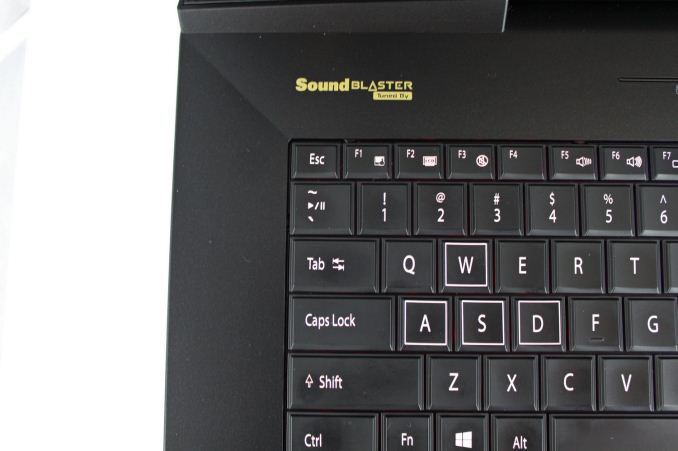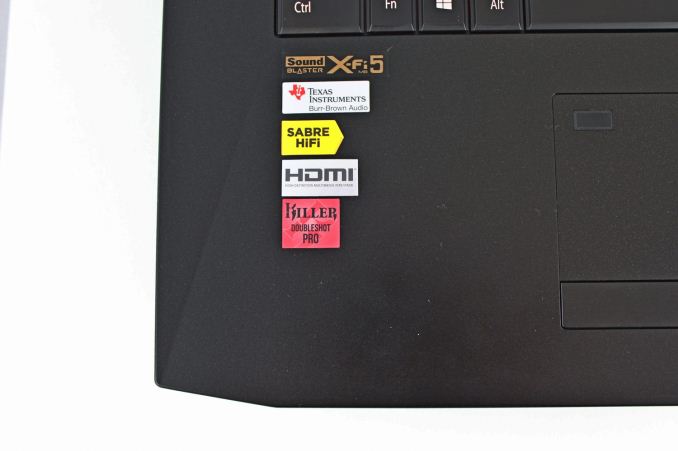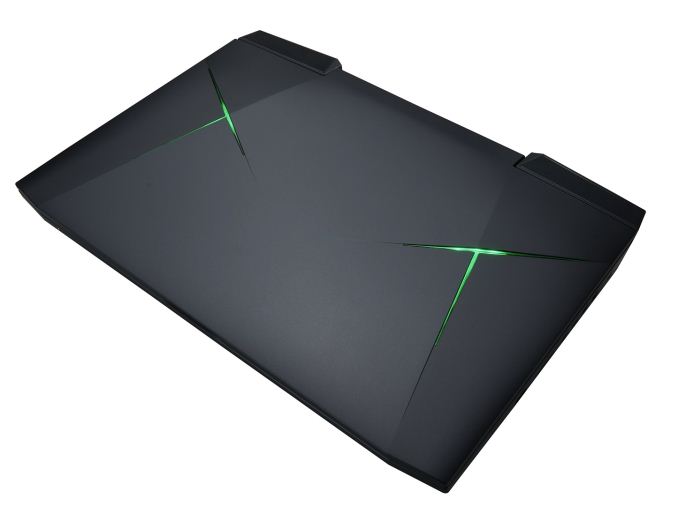The Clevo P870DM2 / Mythlogic Phobos 8716 Laptop Review: DTR With GTX 1080
by Brett Howse on October 27, 2016 2:00 PM ESTFinal Words
What else is there to say about this notebook? If you are after a desktop replacement, the market shrinks considerably, and very few companies offer desktop class processors in notebooks these days. Clevo is one of them, and they have shoehorned a full 91-Watt overclockable processor into this notebook. On CPU bound tasks, it is very likely that there is no other high volume notebook that is faster than this one. The performance is very impressive.
On the GPU side, there are plenty of options here too, but all of them based on the new Pascal architecture from NVIDIA. With just a 1920x1080 panel to push, even the GTX 1070 is going to have very good performance, but the GTX 1080 is such a big step up in the notebook market that it’s almost difficult to believe. It is basically twice as fast as the outgoing GTX 980M in real-world gaming tests. The GTX 980M was no slouch, but with NVIDIA moving to the full desktop class GPUs in notebooks this year, the jump in performance is as big as any seen in recent years. For those that really want the best of the best, Mythlogic offers this laptop with SLI GTX 1080 (or 1070), and choices of a 1920x1080 IPS 120 Hz display, 2560x1440 120 Hz G-Sync display, and 3840x2160 60 Hz G-Sync as well. The lower resolution display does have the advantage of being a 120 Hz display though, and the GTX 1080 can pretty easily drive most games at or above that refresh rate. The 2560x1440 seems like a great sweet spot for the non SLI models though, especially with G-Sync.
There are a lot of configurations available, which is typical of these types of systems, and it’s nice to be able to pick and choose your components a bit more than the larger OEMs allow. There is room for multiple M.2 SSDs, multiple 2.5-inch SSDs, and four SO-DIMM slots for memory. All of the components can be accessed through the bottom, or by removing the keyboard.
The chassis is far from the best around, with it being a large, thick, machine, made entirely of black plastic. The styling is ok though, with no crazy artwork or anything, and honestly for a notebook that is going to live its life on a desk, it is going to be absolutely fine.
What isn’t as fine is the keyboard. MSI has a fully mechanical keyboard in the GT83VR Titan, Razer has low profile mechanical switches in the new Razer Blade Pro, and Alienware has really worked hard at improving their keyboard as well with this generation. The Clevo keyboard feels like it is from about a decade ago, with very little travel despite the notebook being almost two inches thick. The keys themselves have very little bevel to them, and all of the keys are packed in so tight that it is very easy to lose where you are and hit the wrong key by mistake. If you are going to use this as a true desktop replacement, I suppose an external keyboard is an option, but it really shouldn’t need to be this way. The trackpad is just average, but here it’s difficult to be too critical since almost everyone that purchases a laptop like this is going to use it with a mouse.
At the end of the day, I am not the target market for this device. I have a desktop, and I haven’t moved houses in over a decade, but you can certainly see the appeal of having all the performance of a desktop in something you can move around a lot easier. Maybe you travel for work, or maybe you go to school, but being able to pick up a full desktop with the display attached and put it in a big is going to be a nice perk. And, even with all of these powerful components inside, the pricing is very reasonable. It’s hard to say something that starts at $2250 is inexpensive, but for what you get it is not. The base model still has a GTX 1070 and a desktop class 65-Watt CPU, and a 120 Hz display. You can tack on a lot of options to really drive up the price, but even this review unit with a GTX 1080, 32 GB of memory, and a Core i7-6700K still comes in under $3000. For that money, you won’t be able to find another laptop with this much performance available.













61 Comments
View All Comments
BrokenCrayons - Thursday, October 27, 2016 - link
Minor details...the MYTH Control Center shows an image of a different laptop. It struck me right away because of the pre-Pentium MMX Compaq Presario-esque style hinge design.As for Pascal, the performance is nice, but I continue to be disappointed by the cooling and power requirements. The number of heat pipes affixed to the GPU, the fact that it's still reaching thermal limits with such cooling, and the absurd PSU requirements for SLI make it pretty obvious the whole desktop-class GPU in a laptop isn't a consumer-friendly move on NV's part. Sure it cuts back on engineering, manufacturing, and part inventory costs and results in a leaner organization, but it's hardly nice to people who want a little more than iGPU performance, but aren't interested in running up to the other extreme end of the spectrum. It's interesting to see NV approach the cost-cutting measure of eliminating mobile GPU variants and turning it into a selling point. Kudos to them for keeping the wool up on that aspect at least.
The Killer NIC is something I think is a poor decision. An Intel adapter would probably have been a better choice for the end user since the benefits of having one have yet to be proven AND the downsides of poor software support and no driver flexibility outweigh the dubious claims from Killer's manufacturer.
ImSpartacus - Thursday, October 27, 2016 - link
Nvidia just named their mobile GPUs differently.Fundamentally, very little has changed.
A couple generations ago, we had a 780mx that was based on an underclocked gk104. Nvidia could've branded it as the "laptop" 770 because it was effectively an underclocked 770, just like the laptop 1080 is an underclocked 1080.
But the laptop variants are surely binned separately and they are generally implemented on the mxm form factor. So there isn't any logistical improvements just by naming their laptop GPUs differently.
The_Assimilator - Thursday, October 27, 2016 - link
"The number of heat pipes affixed to the GPU, the fact that it's still reaching thermal limits with such cooling, and the absurd PSU requirements for SLI make it pretty obvious the whole desktop-class GPU in a laptop isn't a consumer-friendly move on NV's part."nVIDIA is doing crazy things with perf/watt and all you can do is complain that it's not good enough? The fact that they can shoehorn not just one, but TWO of the highest-end consumer desktop GPUs you can buy into a bloody LAPTOP, is massively impressive and literally unthinkable until now. (I'd love to see AMD try to pull that off.) Volta is only going to be better.
And it's not like you can't go for a lower-end discrete GPU if you want to consume less power, the article mentioned GTX 1070 and I'm sure the GTX 1060 and 1050 will eventually find their way into laptops. But this isn't just an ordinary laptop, it's 5.5kg of desktop replacement, and if you're in the market for one of these I very much doubt that you're looking at anything except the highest of the high-end.
BrokenCrayons - Thursday, October 27, 2016 - link
Please calm down. I realize I'm not in the target market for this particular computer or the GPU it uses. I'm also not displaying disappointment in order to cleverly hide some sort of fangirl obsession for AMD's graphics processors either. What I'm pointing out are two things:1.) The GPU is forced to back off from its highest speeds due to thermal limitations despite the ample (almost excessive) cooling solution.
2.) While performance per watt is great, NV elected to put all the gains realized from moving to a newer, more efficent process into higher performance (in some ways increasing TDP between Maxwell/Kepler/etc. and Pascal in the same price brackets such as the 750 Ti @ 60W vs the 1050 Ti @ 75W) and my personal preference is that they would have backed off a bit from such an aggressive performance approach to slightly reduce power consumption in the same price/performance categories even if it cost in framerates.
It's a different perspective than a lot of computer enthusiasts might take, but I much perfer gaining less performance while reaping the benefits of reduced heat and power requirements. I realize that my thoughts on the matter aren't shared so I have no delusion of pressing them on others since I'm fully aware I don't represent the majority of people.
I guess in a lot of ways, the polarization of computer graphics into basically two distinct categories that consist of "iGPU - can't" and "dGPU - can" along with the associated power and heat issues that's brought to light has really spoiled the fun I used to find in it as a hobby. The middle ground has eroded away somewhat in recent years (or so it seems from my observations of industry trends) and when combined with excessive data mining across the board, I more or less want to just crawl in a hole and play board games after dumping my gaming computer off at the local thrift store's donation box. Too bad I'm screen addicted and can't escape just yet, but I'm working on it. :3
bji - Thursday, October 27, 2016 - link
"Please calm down" is an insulting way to begin your response. Just saying.BrokenCrayons - Thursday, October 27, 2016 - link
I acknowledge your reply as an expression of your opinion. ;)The_Assimilator - Friday, October 28, 2016 - link
Yeah, but my response wasn't exactly calm and measured either, so it's all fair.BrokenCrayons - Friday, October 28, 2016 - link
"...so it's all fair."It's also important to point out that I was a bit inflammatory in my opening post. It wasn't directed at anyone in particular, but was/is more an expression of frustration with what I think is the industry's unintentional marginalization of the lower- and mid-tiers of home computer performance. Still, being generally grumpy about something in a comments box is unavoidably going to draw a little ire from other people so, in essence, I started it and it's my fault to begin with.
bvoigt - Thursday, October 27, 2016 - link
"my personal preference is that they would have backed off a bit from such an aggressive performance approach to slightly reduce power consumption in the same price/performance categories even if it cost in framerates."They did one better, they now give you same performance with reduced power consumption, and at a lower price (980 Ti -> 1070). Or if you prefer the combination of improved performance and slightly reduced power consumption, you can find that also, again at a reduced price (980 Ti -> 1080 or 980 -> 1070).
Your only complaint seems to be that the price and category labelling (xx80) followed the power consumption. Which is true, but getting hung up on that is stupid because all the power&performance migration paths you wanted do exist, just with a different model number than you'd prefer.
BrokenCrayons - Thursday, October 27, 2016 - link
You know, I never thought about it like that. Good point! Here's to hoping there's a nice, performance boost realized from a hypothetical GT 1030 GPU lurking in the product stack someplace. Though I can't see them giving us a 128-bit GDDR5 memory bus and sticking to the ~25W TDP of the GT 730. We'll probably end up stuck with a 64-bit memory interface with this generation.